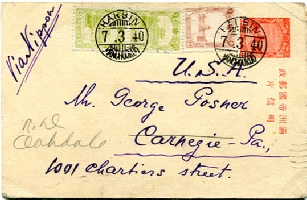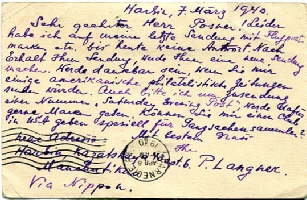
Cliquez sur les images pour agrandir -

LETTRE
7 mars 1940 -
–
March 7th, 1940 -
Les entiers postaux ne se rencontrent pas souvent voyagés. L’expéditeur de celui-
« Cher Monsieur Postner, malheureusement je n’ai reçu aucune réponse à mon dernier envoi par la poste aérienne (timbres etc…). Après réception de votre envoi, je vais vous faire un nouvel envoi. Si vous pouviez m’adresser quelques journaux philatéliques américains, je vous en serais reconnaissant. De même, je vous prie de me faire parvenir un numéro du ‘Saturday Evening Post’, en échange duquel je donnerais volontiers des timbres. Pouvez-
La ville de destination, « Carnegie », est un arrondissement du comté d'Allegheny, en Pennsylvanie. Il fait partie de la région métropolitaine de Pittsburgh. Cette ville porte le nom d' Andrew Carnegie, en remerciement du don de l'une de ses bibliothèques.
Andrew Carnegie (1835-
Arrivée à destination la carte est re-
Sources :
(1) Remerciements à B. Joyeux-
(2) NdT : Cette dernière phrase n’est pas très claire.
(3) Grand Larousse Universel, Vol 3, p 1802
|
Dimensions : |
90 x 140 mm |
|
|
Tarif : |
Carte pour l’international………. |
10 fens |
|
Période de valeur : |
Du 01/04/1937 au 15/08/1945 |
|
|
Timbres utilisés : |
YT n°77 et 81 (paire) |
|
|
Oblitération : |
N°43.1 Harbin 07/03/1940 |
|
|
Période d’utilisation : |
Du 09/04/1936 au 25/09/1944 |
|
|
Indication : |
« Via Nippon » manuscrit |
|
|
Arrivée : |
Oblitération mécanique Carnegie 08/04/1940 |
|
|
Size : |
90 x 140 mm |
|
|
Rate : |
Foreign postcard……………….. |
10 fen |
|
Period of rate : |
04/01/1937 to 08/15/1945 |
|
|
Stamps : |
SG n°80, 84 (in pair) |
|
|
Postmark : |
N°43.1 Harbin 03/07/1940 |
|
|
Period of use : |
04/09/1936 to 09/25/1944 |
|
|
Instruction : |
« Via Nippon » handwriten |
|
|
Arrival : |
Mecanic cancellation Carnegie 04/08/1940 |
|


Postal stationery is not often seen travelling. The sender of this one has, of course, supplemented the basic postage as necessary to meet the rate in force for the period. As is often the case, we are dealing here with a philatelist, according to the text of the correspondence (1):
"Dear Mr Postner, unfortunately I have not received any reply to my last letter sent by airmail (stamps etc...). Once I have received your shipment, I will send you a new one. If you could send me some American philatelic journals, I would be grateful. I would also be grateful if you could send me an issue of the ‘Saturday Evening Post’, in exchange for which I would be happy to donate stamps. Can you give me details of a Club in the USA that specialises in things 'Pang'?(2) With best regards...P. Langner".
The destination city, "Carnegie", is a borough in Allegheny County, Pennsylvania. It is part of the Pittsburgh metropolitan region. The town is named after Andrew Carnegie, in recognition of the donation of one of his libraries.
Andrew Carnegie (1835-
Once there, the map is redirected to another town whose name could be 'Asdhale' ??.
Sources :
(1) Thanks to B. Joyeux-
(2) NdT: This last sentence is not very clear.
(3) Grand Larousse Universel, Vol 3, p 1802